Hitec RCD OPT5-24G 2.4GHz RADIO CONTROL SYSTEM User Manual
Hitec RCD Inc. 2.4GHz RADIO CONTROL SYSTEM Users Manual
Users Manual
OPTIC5 2.4 USER MANUAL
Hitec RCD INC.
Introducing the Optic 5 2.4
Congratulations and welcome to the R/C world! You now own a basic, but unusually versatile and
powerful, 5-Channel beginner’s RC transmitter.
The Optic 5 2.4 is all the radio you need to fly the most of 5-Channel fixed-wings aircraft models.
Standard features include servo-reversing for all channels, trim adjustments on all control channels,
ATV (Adjustable Travel Volume) on Aileron (CH.1) and Elevator (CH.2).
The Optic 5 2.4 features:
Pre-mixed Flight Control Functions:
The Optic 5 2.4 computer automatically mixes rudder and elevator outputs to control a V-tail or mixes
aileron and elevator outputs to create elevons for tail-less flying wings, eliminating the need for on-
board mixing systems.
Trim Adjustment Function:
This computerized radio allows you to easily tune and coordinate the control surfaces (such as
keeping a rudder centered or two ailerons-each on their own servo-moving the same amount) without
having to physically re-adjust linkages.
Buddy-Box Function:
For those learning to fly, the transmitter has a "buddy-box" capability so that you can use the optional
trainer cord to connect your Optic 5 2.4 to another Hitec transmitter (Master)*. This function allows
one transmitter to be used by an instructor as the primary flight control while the other is controlled by
the student pilot.
*Note: Optic 5 2.4 only can be used as a Pupil (Slave) transmitter.
If you are new to Computerized RC Transmitters
If OPTIC 5 2.4 is your first radio control transmitter, you're probably feeling a bit overwhelmed.
However, if you take little time to read this manual and follow the programming steps as you watch
your model's control surfaces respond, handling the Optic 5 2.4 will soon become quite comfortable.
So stick with it. Learning the programming basics won't take any longer or require any more brain
power than it takes to do the average crossword or Sudoku puzzle.
You'll discover that the rewards for mastering this simple radio are well worth the effort.
TIP:
Throughout the manual you will see our "Tip Sheet" notes.
These highlight specific function details we didn't want you to miss within the body of the manual.
Check these out; they can make programming the Optic Sport easier.
Hitec AFHSS 2.4GHz Technology
Most of Hitec’s 2.4GHz product uses AFHSS (Advanced Frequency Hopping Spread Spectrum)
technology which gives you highly stable one-way and telemetric signals for ensure safe flight of your
model aircrafts.
Equipment Mounting
When you mount each servo, use the supplied rubber grommets and insert an eyelet up through the
bottom. Be sure not to over tighten the screws.
If any portion of the servo case directly contacts the fuselage or the servo rails, the rubber grommets
will not be able to attenuate vibration, which can lead to mechanical wear and possible servo failure.
Servo Throw
Once you have installed the servos, operate each one over its full travel and check that the pushrod
and output arms do not bind or collide with each other, even at extreme trim settings.
Check to see that each control linkage does not require undue force to move (if you hear a servo
buzzing when there is no transmitter control motion, most likely there is too much friction in the control
or pushrod).
Even though the servo will tolerate loads like this, they will drain the battery pack much more rapidly
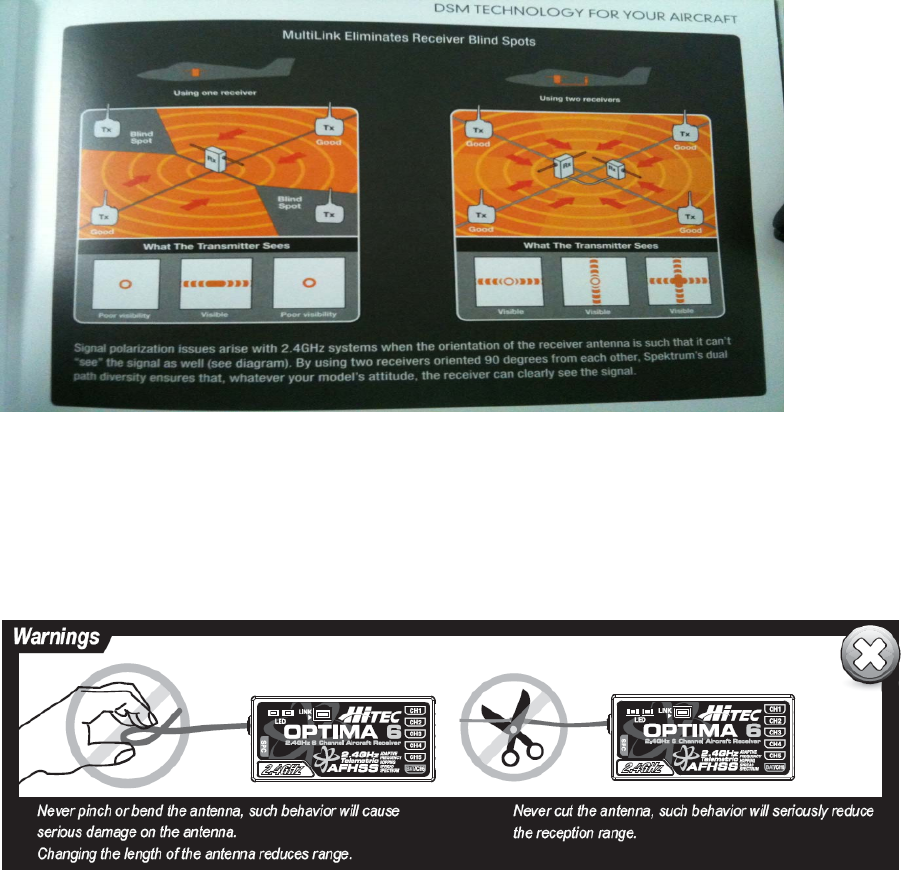
Receiver Installation and Setup Note:
Vibration and Water
The receiver contains precision electronic parts. Be sure to avoid vibration, shock, and temperature
extremes.
For protection, wrap the receiver in the provided "Flight Preserver" foam rubber, or use some other
vibration-absorbing materials.
If you are flying near bodies of water, it's also a good idea to protect the receiver by placing it in a
plastic bag and securing the open end of the bag with a rubber band before wrapping it with foam. If
you accidentally get moisture inside the receiver, you may experience intermittent operation or a crash.
Switch Harness Installation
When you are ready to install the receiver's switch harness, remove the switch cover and use it as a
template to cut screw holes and a rectangular hole slightly larger than the full stroke of the switch.
Choose a switch location on the opposite side of the fuselage from the engine exhaust, and choose a
location where it can't be inadvertently turned on or off during handling or storage. Install the switch so
that it moves without restriction and "snaps" from ON to OFF and vice versa.
M-BODA (Mini Boosted Omni-Directional Antenna) Installation
You may run the antenna inside of a non-metallic housing within the fuselage (a plastic outer pushrod
housing works well for this), but range may suffer if the antenna is located near metal pushrods or
cables. Be sure to perform a range check before flying. With the 2.4GHz radio system,
the range check method is different from the conventional frequency radio system.
During the range check period, you should be able to walk away at least 75 feet from the model
without losing control or seeing "jitter" in the servos. The range check should be done with the motor
running and the model should be securely restrained in case of loss of control.
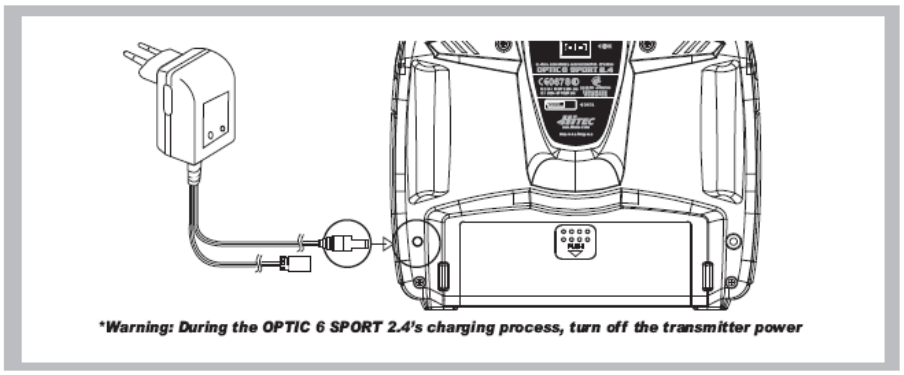
Connectors
Be sure the alignment of a servo or battery connector is correct before inserting it into the receiver. To
remove a connector from the receiver, try to pull on the connector's plastic housing rather than pulling
on the wires. Pulling the wires can ruin the connector pins and break wires.
Using Servo Wire Extensions
If any of your servos are located too far away to plug directly into the receiver (like the aileron servo),
or you need to unplug the servo each time you disassemble the model, use a servo extension cord to
extend the length of the servo lead.
Additional Hitec extension cords of varying lengths are available from your hobby dealer.
Charge the Batteries!
Before we dive into the use of the Optic 5 2.4, let's charge the batteries.
1. Connect the transmitter charging cord to the transmitter's charging socket (on the rear of the case,
left side).
2. If your aircraft uses a receiver battery, connect it to the receiver connector on the charging cord.
3. Plug the charger into a wall socket.
4. The charger's LEDs should light, indicating charging is in progress.
If either light does not turn on, verify that the transmitter and receiver power switches are OFF.
The batteries should be left on charge for about 15 hours.
Try to charge the batteries with the charger supplied with your system exclusively.
The use of a fast-charger may damage the batteries by overheating and dramatically reduce their
lifetime.
NOTE: If you need to remove or replace the transmitter battery, do not pull on its wires to remove it.
Instead, gently pull on the connector's plastic housing where it plugs in to the transmitter.
The battery must be removed to charge it properly with a "peak" charger.
Be careful if you do choose to use a field charger on your batteries.
A fast-charger may overcharge the batteries, causing overheating and a premature failure. Never
charge your transmitter or receiver battery at a rate higher than the batteries capacity.
For example, the capacity of your Optic 6 Sport's 7.2 volt NIMH battery is 1300mAh and, therefore,
should not be charged at a rate any higher than 1.3 amps.
Caution: Stop flying and bring back your aircraft and land at once, when your transmitter start beeps
for low battery warning. (L.B.W. activates when battery level hits below 6.6V)
A training cable may be used to help a beginning pilot learn to fly safer by allowing a second
transmitter, operated by an experienced instructor, to be connected to the Optic 6 Sport 2.4 transmitter.
The instructor may override the beginner at any time to bring the model back under safe control. For
training, the transmitter may be connected to another Hitec 2.4GHz system using the Hitec cord part
No. #58320 TRAINER CABLE (between 6 cell transmitter battery systems) or #58321 TRAINER CABLE
FULL PACKAGE (#58320 + Slave DIN + Master DIN) - For use between a 6 cell transmitter battery
system and 8 cell transmitter battery system.
Operating with a Trainer Cord
NOTE:
1. WHEN USING THE TRAINER SYSTEM IN THE STEREO JACK TO STEREO JACK FORMAT AS
NOTED IN THE NEXT SEVERAL PARAGRAPHS, BOTH TRANSMITTERS ARE GOING TO
TRANSMIT.
2. IF THE SLAVE TRANSMITTER HAS A REMOVABLE MODULE, REMOVE IT.
THEN, IT WILL NOT BE TRANSMITTING. OTHERWISE, IF YOU ARE FLYING AT A CLUB FIELD
USING FREQUENCY CONTROL, BE SURE YOU HAVE THE OK TO USE BOTH FREQUENCIES.
3. IF THERE IS NO REMOVABLE MODULE ON THE SLAVE TRANSMITTER, BOTH
TRANSMITTERS MUST BE ON DIFFERENT FREQUENCIES.
1. To use the trainer system between STEREO Jack Transmitter and STEREO Jack Transmitter
(Needs #58320 between 6 cell Battery Radios)
1) Set up both the student's and instructor's transmitter to have identical trim and control motions. If
the instructor's transmitter is on a different frequency than the student's, use the student's transmitter
as the master transmitter, and the other transmitter as the student's.
2) Turn on the instructor's transmitter and DO NOT turn on the student's transmitter power.
Plug Trainer Cord (#58320 Stereo Jack) accordingly into each transmitter. The trainer jack is on the
back of the transmitter.
Then you can see "MAS MODE" on the LCD screen of Instructor's transmitter and "SLV MODE" on
the Student's transmitter screen.
3) Move the controls on the instructor's transmitter, and verify each control moves the proper direction.
Now verify that the student's trims and control travels match the instructor's by using the trainer button
(the momentary ENG CUT/TRAINER button on the top right of the transmitter case) and switching on
and off while leaving the control sticks and trims alone, then moving the control sticks.
4) The instructor's transmitter has normal control over the model unless the trainer button is pressed,
passing control to the student's transmitter.
If the student loses control, the instructor can quickly "take over" by releasing the trainer button and
then controlling the model.
2. To use the trainer system between a STEREO Jack Transmitter and a DIN Jack Transmitter.
(Needs trainer cable package #58321 between 6 cell Battery Radio and 8 cell Battery Radio system)
ease read the following instruction carefully for using transmitters with DIN Jack and/or stereo jack for
the trainer system. You will need the Trainer cable full package (#58321).
This full package is consists of a STEREO Jack trainer cable(#58320), Instructor DIN Jack and
Student DIN Jack Adapter.
This package allows the proper connection between a 6 cell battery system radio (ex. Optic 6 Sport
2.4, Aurora 9) and 8 cell battery system radios (ex. Optic 6 2.4 / Eclipse 7 2.4).
NOTE
This section tells you how to connect the transmitters only.
Please read the prior sections for the full information needed to properly operate the trainer cable
system.
3. Between the Transmitter having a STEREO jack as INSTRUCTOR and Transmitter having DIN jack
as STUDENT.
1) Power on the INSTRUCTORS Transmitter having the STEREO Jack.
2) Plug the STEREO Jack trainer cable (#58320) into the Master, or INSTRUCTORS transmitter.
Note: you will see "MAS MODE" on LCD screen which means the transmitter is recognized as the
INSTRUCTOR or "Master".
3) Connect the DIN Jack adapter marked "STUDENT" from the cable package #58320 to the other
end of the stereo connector cable.
This combination enables you to connect the cable to the STUDENT transmitter with a DIN Jack
connector.
4) Plug the DIN connector into the socket on the STUDENT transmitter.
5) Finally, power on the STUDENT transmitter. Though it is powered on, the STUDENT transmitter will

not transmit the radio signal as long as the trainer cable is connected properly.
NOTE: There is no sign of recognition on the LCD screen of the Transmitter using the DIN jack.
4. Between the Transmitter having a DIN jack as INSTRUCTOR and a Transmitter having a STEREO
jack as STUDENT.
1) Connect the INSTRUCTOR or DIN Jack adapter marker "Master" with #58320 stereo jack Trainer
cable.
2) Power on the INSTRUCTOR transmitter.
3) Plug the combined trainer cable into the INSTRUCTOR transmitter DIN jack connection.
4) The STUDENT transmitter should be turned off.
5) Plug the trainer cable into the STUDENT transmitter with the stereo jack. The power to the
STUDENT transmitter will turn on automatically and you will see "SLV MODE" on the LCD screen
which means the transmitter is recognized as STUDENT or "Slave".
6) Though the STUDENT transmitter is powered on automatically, it will not transmit a radio signal as
long as the trainer cable is connected properly.
NOTE
1) Do NOT turn on the power of the STUDENT transmitter having the STEREO Jack. Once you plug
the trainer cable into the STUDENT Transmitter using the STEREO Jack, it will be powered on
automatically.
2) All Transmitters in the trainer system use their own batteries. Both batteries in both the Instructor
and Student Transmitters should be properly charged and installed when flying in the trainer mode.
3) You may wish to use a simple "contractors cord" knot on the cable to adaptor connection to keep it
from coming "unplugged" when using it. Heat shrink tubing or electrical tape can also be used.
Stick Length Adjustment
Hands come in all sizes so to accommodate everyone we use a two piece stick “top” that can be
adjusted to fit a wide variety of users.
Separate the top from the bottom piece and adjust the top piece to the length required.
Screw the bottom up against the top piece to “jam” lock everything into position.
Stick Lever Tension Adjustment / Mode Change
Stick Lever Tension Adjustment
You may adjust the stick tension of your sticks to provide the "feel" that you like for flying. To adjust
your springs, you'll have to remove the case of the transmitter. Using a screwdriver, remove the six
screws that hold the transmitter's rear cover into position, and put them in a safe place. Now, place
some padding under the front of the transmitter and set it face-down on the pad.
Gently ease off the transmitter's rear cover. Now you'll see the view shown. Use a small cross-point
screwdriver, rotate the adjusting screw for each stick for the desired spring tension.
The tension increases when the adjusting screw is turned clockwise, and decreases for
counterclockwise motion.
Note: Please use M2 (2mm) or 5/64inch Hex key for tension adjustment and mode changes.
When you are satisfied with the spring tensions, you may close the transmitter. Very carefully reinstall
the rear cover. When the cover is properly in place, tighten the six screws.
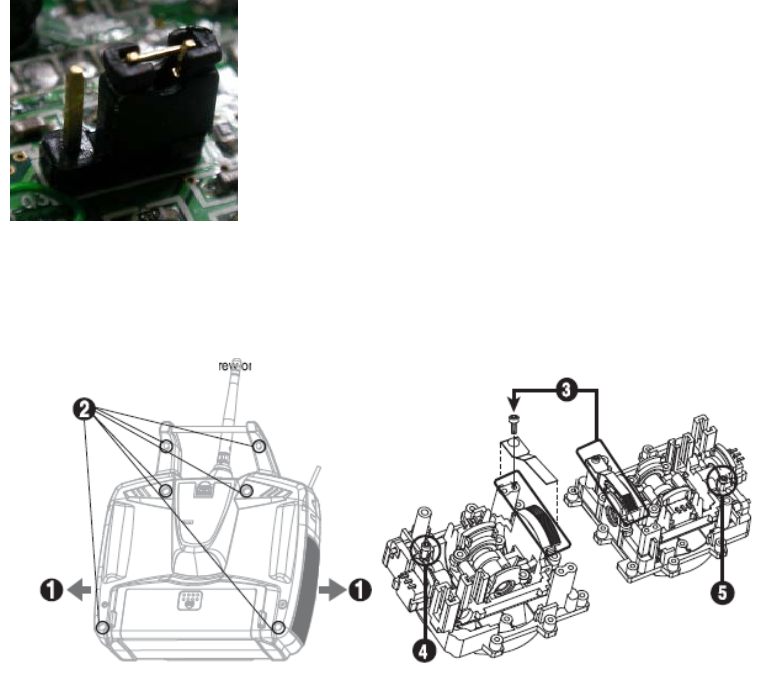
Change to ‘Mode 1’ Configuration
All Optic 6 Sport 2.4 systems sold in US are in ‘Mode 2’ format. However, you may wish to use Optic 6
Sport in ‘mode 1’ format. There is a menu choice for this option in the Initial Set-Up function menu
described on Page 15.
After selecting ‘Mode 1’ in the Initial Set-Up Menu, you must do the following hardware set-up in order
to change the transmitter
1. Carefully remove the plastic side panels from the transmitter.
2. Remove all the six philips screws from the back of the case.
3. Unscrew a hex screw to remove the Copper Ratchet from where it is located and move it to the
other side.
4. Allocate the “Mode Selection Jumper” to be connected with the other two.
4. Tighten up the tension spring hex screw on the new location, and try control the stick and feel it first
if you like the tension of control stick.
5. Loosen up the tension spring hex screw on the original location.
6. Re-assemble the case.
Flying Safety
To ensure your own safety and the safety of others, please observe the following precautions:
Flying field
We recommend that you fly at a recognized model airplane flying field.
You can find model clubs and fields by asking the nearest hobby dealer, or contacting the Academy of
Model Aeronautics.
Always pay particular attention to the flying field's rules, as well as the presence and location of
spectators, the wind direction, and any obstacles on the field.
Be very careful flying in areas near power lines, tall buildings, or communication facilities as there may
be radio interference in their vicinity.
Once you arrive at the flying field...
- Before you fly, perform a range check to confirm your radio system is responding correctly.
- To do a range check, Power-up the aircraft and either ask a friend to help hold the aircraft or secure
it somehow.
- Walk away from the aircraft until the aircraft "glitches" or you notice intermittent control loss.
- Walk back to the aircraft, pacing out the distance.
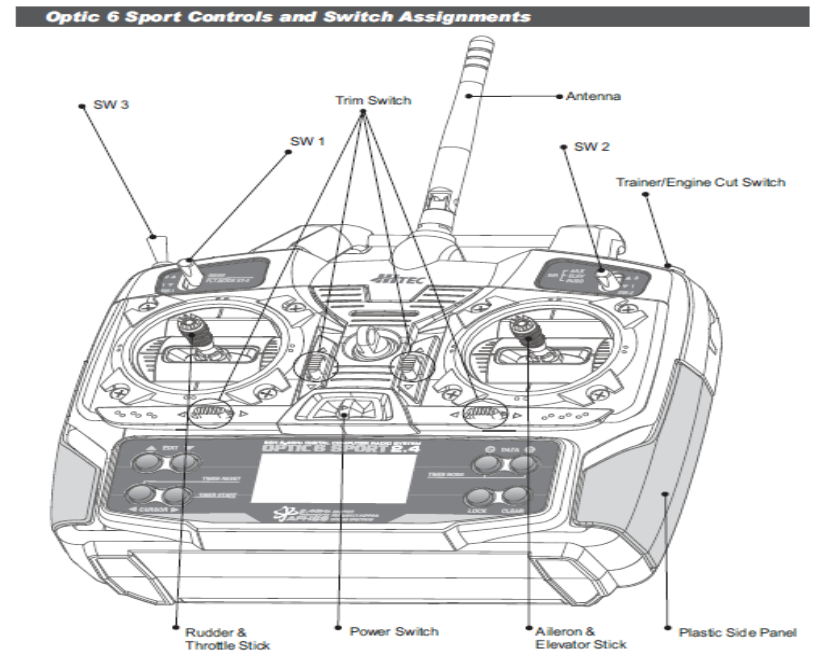
Note: We want a good range check to be at least 75 feet or so.
- When you are ready to fly your model, position the throttle stick or switch to its low speed or off
position.
Then, you may turn on the transmitter power followed by the receiver power.
- When you have finished flying, turn off the receiver power first then turn off the transmitter power.
If you do not follow these procedures, the receiver has no information to hold the servos steady and
you may damage your servos or control surfaces or flood your motor.
- In case of electric-powered models the motor may unexpectedly turn on and cause a severe injury if
the transmitter is switched off before the receiver.
- Before starting the engine, power up the transmitter and receiver, and check to be sure that the
servos follow the movement of the sticks.
- If a servo operates abnormally, don't attempt to fly until you determine the cause of the problem.
- Before starting the engine, be sure to check that the transmitter model memory is correct for the
chosen model.
- While you're getting ready to fly, if you place your transmitter on the ground, be sure that the wind
won't tip it over.
- If it is knocked over, the throttle stick may accidentally get moved causing the engine to race
unexpectedly, causing damage or injury to anyone nearby.
- Finally, don't fly in the rain! Water or moisture may enter the transmitter through the antenna or stick
openings and cause erratic operation or loss of control.
If you must fly in wet weather during a contest, be sure to protect your transmitter with a plastic bag or
waterproof barrier.
Optic 5 2.4 Specification, Controls and Switch Assignments
On-Off Switch
This switch does more than just turn the radio on and off-it also gets you into the initial setup Mode to
Link the receivers (One-way, and Telemetry)
The switch is coupled to the two LED Indication lights located an inch above it and an inch low left
corner-they come on when the switch turned on and go off when the switch is turned off.
Optic 6 Sport Programming Switches and Buttons
Joystick Controls
Optic 5 2.4GHz Transmitter Features
Minima 6T Receiver Features
Minima 6T Receiver Connection Diagrams
Glow, gas, nitro or electric powered aircraft using a separate receiver battery
Electric powered aircraft with Electronic Speed Control
Minima Series Receiver Features
Minima Series Receiver Features and setup
Set-up and Use of the Hitec 2.4GHz System
Receiver-Servo Connection List
Optic 5 2.4, ACRO in-Flight Controls
Model Setup Menu Programming for Powered Airplanes (ACRO)
EPA (End Point Adjustment)
EPA (End Point Adjustment)
The EPA function is used to set (or limit) the travel of each servo, and may be set anywhere from 0%
and 125% for each travel direction. Reducing the percentage settings reduces the total servo throw in
that direction. The EPA function is normally used to prevent any servos from binding at the ends of
their travel.
Setting up End Points
In this menu function you can set aileron up and down travel, up and down elevator travels, right and
left rudder travels, open and closed throttle positions, and aileron up and down travels if you have a
second servo for the left wing. You can also set the end point travel of flaps and landing gear.
ATV (Adjustable Travel Volume) Function
ATV function is somewhat similar to EPA (End Point Adjustment) and D/R (Dual Rate) function; it
allows you to adjust a servo’s travel end position amount over a control sticks movement.
ATV function affects both endpoints at once, while EPA function allows a servos’ each end of travel
individually. This function can be found useful when the plane is too sensitive over a control sticks’
movement.
Trim Adjustment
This is a function for setting the trim values for each of the servos, allowing you to make adjustments
to each individual servo independently of the trim switches located near the control stick of the radio
(which can be adjusted in flight).
We recommend that you first set up the model's servo pushrods so that the control surfaces are as
centered as possible mechanically before attempting to adjust them in the trim switch. We also
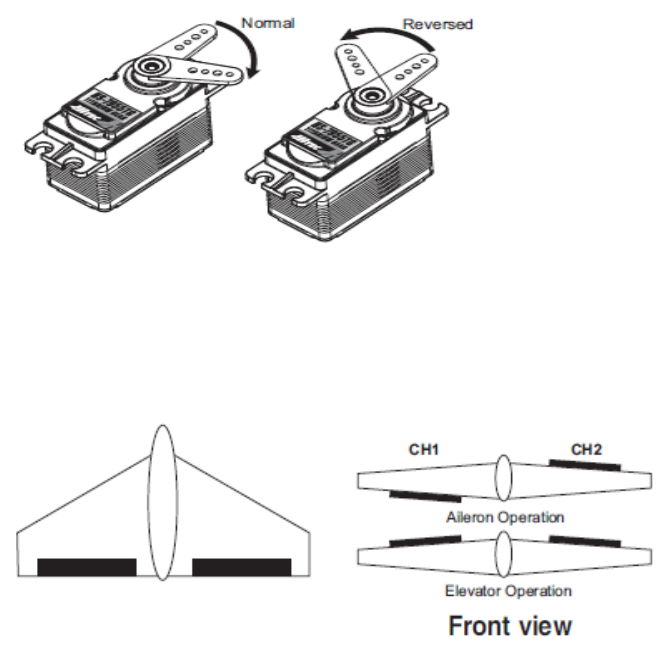
recommend that you try to keep all the trim values at the center position. If the values skewed to once
side, the servo's full range of travel may be restricted.
Setting Trims
At this point you must have your plane in front of you and turned on so you can actually see when the
control services are in alignment as you change the trim value.
1. Starting with the CH 1 aileron servo, use the trim switch to either increase or decrease the trim
value until the control surface is properly aligned on the model.
2. Move over to CH 2 with the trim switch and align the elevator in the same way.
3. Continue by moving to CH 3 for throttle and CH 4 for align the rudder.
S. REV (Servo Reverse)
When you first turn on your model, you will immediately see whether all the control surfaces are
moving in the correct direction when you wiggle the controls.
If any are moving in reverse, you can come to this screen to reverse the throw of the offending servo.
Reversing a Servo
Let's say your elevator is going down when you pull back on the joystick-that is definitely not going to
be a good situation when you go to fly your plane! To reverse the elevator servo, come to the switch in
front of the radio’s front panel. You'll notice that the symbol "NOR" and "REV", move the switch either
NOR or REV to make the servo to operate in proper direction
.
ELVN (Elevon Mix)
If you are setting up a tail-less delta or flying wing aircraft, you can use this program to activate the
pre-programmed elevon mix that mixes the output on the CH 1 aileron and CH 2 elevator servo
channels. (As you will notice in the servo connection chart, you plug one aileron servo in the
receiver's channel 1 slot and the other aileron servo into channel 2-the slot that usually feeds the
elevator.) This is necessary because on these wing types the ailerons must double as elevators.
Setting up Elevons
1) Activate the elevon function by pushing the pre-programmed switch to the left. Now check your
model to see what happens when you move the right-hand joystick side-to-side-the ailerons should go
up and down appropriately.
Move the joystick forward and back to see if the ailerons both respond correctly as elevators. If
necessary, use the REV function to reverse an offending servo.
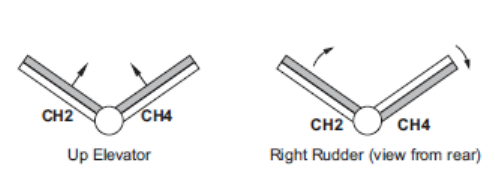
IMPORTANT NOTE:
It is possible due to the particular configuration of your servos that servo reverse won't fix the
problem-you may get the ailerons working properly but not the elevator response on both servos.
Don't worry: You can fix this problem in the elevon programming by changing one of the servo travel
volumes to a negative value.
2) Now set the amount (and direction if necessary as noted above) of each servo-both as ailerons and
as elevators.
Because flying wings are extraordinarily pitch sensitive (because the elevator control surface is so
close to the airframe's center of gravity), you generally need the elevator travel to be much less than
that of the ailerons.
4) When you fly the model, if you find that this 40% reduction isn't enough to take out "pitchiness",
land and further reduce the travel volume.
To tone down the roll response, you can reduce the endpoints of the aileron travel or set up ATV on
CH 1 as described in the setup above.
V.TAL (V-Tail)
This is another built-in mixing program available in the Optic 5 that mixes the rudder and elevator
servos for controlling V-tailed aircraft.
Similar to elevon programming, the two surfaces can move up and down together (for elevator
control) or opposite (for rudder control in this case).
Note: When you select V.TAL, the ELVN program is rendered unavailable.
Setting up a V-Tail
1) Activate the function by pushing the pre-programmed switch to the right.
2) With your model turned on, check your servo travel directions-both rudder and elevator channels-to
be sure they are correct. Use the REV switch if necessary to make the correction.
CUT (Engine Cut Function)
Cut (Engine Cut) Function allows a throttle servo to max out the travel value (you can also choose the
direction by Servo Reverse Function) so that you can immediately cut off the motor when the engine
is below half throttle with a push of the "Eng Cut" button located on the upper right-hand corner of the
transmitter case.
Setting the Engine Cut Function
Press and hold the Cut switch for approximately three seconds to activate Throttle (Engine) Cut
function. The servo will travel more from its lowest (idling) throttle position toward to its End Point by
10%.
Note: Watch the servo movement on your model carefully:
You don't want to overdo the travel value or you'll stall the servo (you'll probably hear it buzzing if it’s
stalled-which creates a drain on the on-board battery and a potential over-heating problem for the
servo).
Setting the Gear (Retractor Gear) Control Function
The same button is used to cut the engine or control the landing gears (Up-locked/Down and Locked).
Use an Y-Cable to connect your retract servos to your receiver’s CH5 then make sure they are
properly operate. Push the Cut/Gear button once shortly to Up-locked or down and locked the
retractable landing gears.
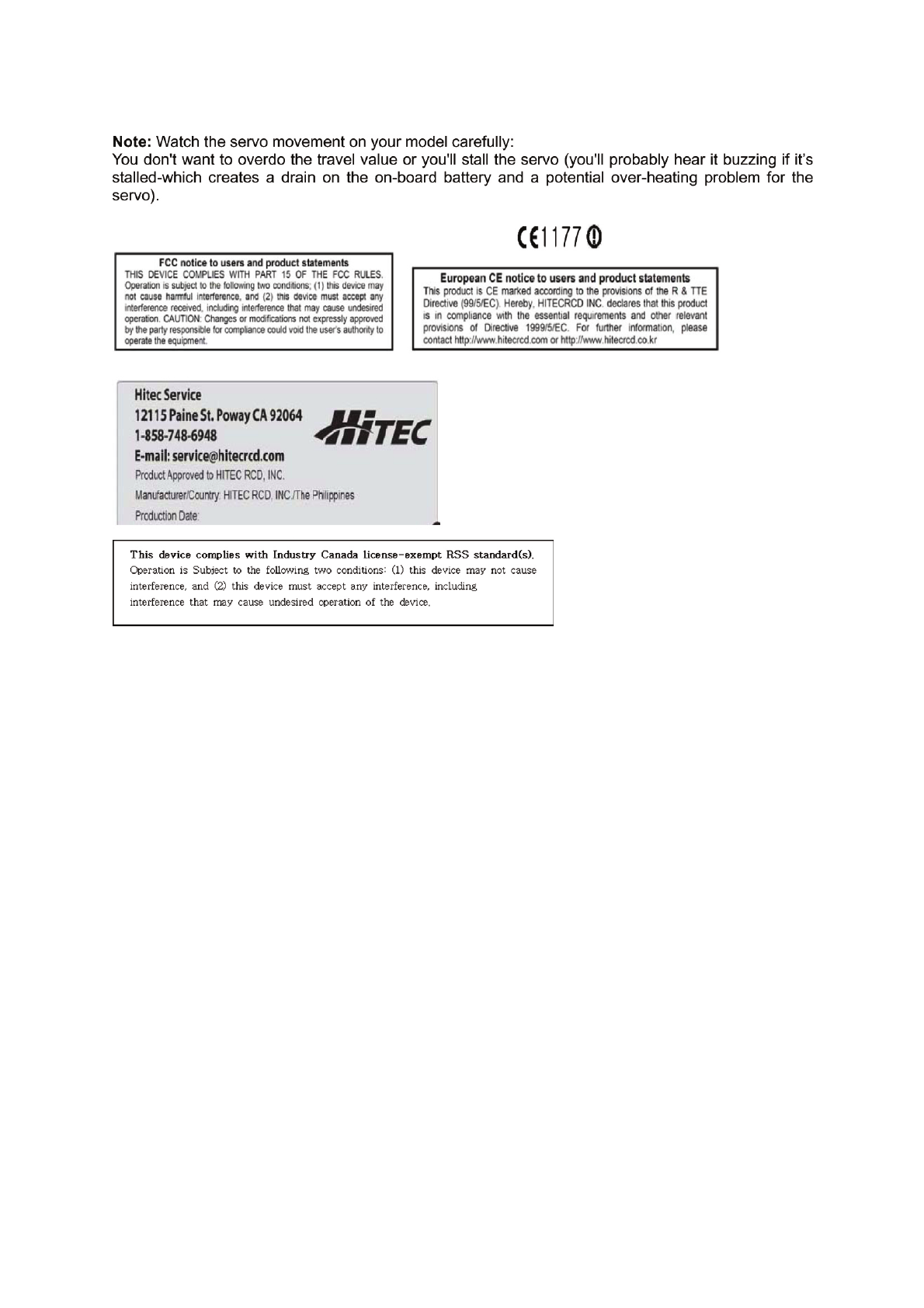
FCC Information to User
This equipment has been tested and found to comply with the limits for a Class B digital device,
pursuant to Part 15 of the FCC Rules. These limits are designed to provide reasonable
protection against harmful interference in a residential installation. This equipment generates,
uses and can radiate radio frequency energy and, if not installed and used in accordance with
the instructions, may cause harmful interference to radio communications. However, there is no
guarantee that interference will not occur in a particular installation. If this equipment does
cause harmful interference to radio or television reception, which can be determined by turning
the equipment off and on, the user is encouraged to try to correct the interference by one of the
following measures:
• Reorient or relocate the receiving antenna.
• Increase the separation between the equipment and receiver.
• Connect the equipment into an outlet on a circuit different from that to which the receiver is
con-nected.
• Consult the dealer or an experienced radio/TV technician for help.
Caution
Modifications not expressly approved by the party responsible for compliance could void the
user’s authority to operate the equipment.
FCC Compliance Information : This device complies with Part 15 of the FCC Rules.
Operation is subject to the following two conditions: (1) This device may not cause harmful
interference, and (2) this device must accept any interference received, including interference
that may cause undesired operation
IMPORTANT NOTE:
FCC RF Radiation Exposure Statement:
This equipment complies with FCC RF radiation exposure limits set forth for an uncontrolled
environment. This equipment should be installed and operated with a minimum distance of 20
centimeters between the radiator and your body.This transmitter must not be co-located or
operating in conjunction with any other antenna or transmitter.

IMPORTANT Safety Instruction:
1) Read these instructions.
2) Keep these instructions.
3) Heed all warnings.
4) Follow all instructions.
5) Do not use this equipment near water.
6) Do not using near any heat sources such as radiators, heat resisters, stove, or other
equipment that produce heat.
CONTACT INFORMATION
Manufacturer Address : 653, YangCheong-Ri, Ochang-Eup, CheongWon-Gun, Chung Buk Province, Korea
To locate in-country Hitec RCD KOREA, INC. distributors of the OPTIC5 2.4,
please refer to the Hitec RCD KOREA, INC. Website http://www.hitecrcd.co.kr/
These distributor(s) represent local contacts for this product.
CORPORATE HEADQUARTERS:
Hitec RCD KOREA, INC.
653, YangCheong-Ri, Ochang-Eup, CheongWon-Gun, Chung Buk Province, Korea
Tel: 82-43-717-2074
Fax:
82-43-717-2193
Web: http://www.hitecrcd.co.kr/

EUROPEAN UNION “DECLARATION OF CONFORMITY”
DECLARATION OF CONFORMITY
Hitec RCD KOREA, INC.
653, YangCheong-Ri, Ochang-Eup, CheongWon-Gun,
Chung Buk Province, Korea
declare under our sole responsibility that the product(s)
2.4GHz Radio Control System – OPTIC5 2.4
to which this declaration relate(s) is in conformance with the following standards:
EN 301 489-1 V1.8.1:2008
EN 301 489-17 V2.1.1 :2009
EN60950-1:2006
EN 300 328 V1.7.1:2006
following the provisions of the 1999/5/EC Directives.